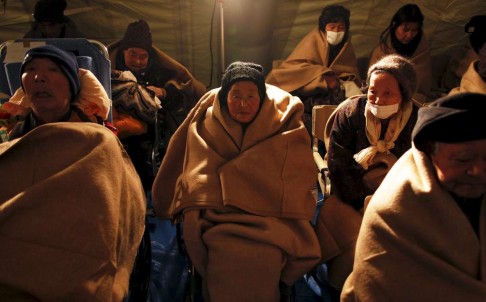Best way to identify a missing person? It’s all in the soles of your feet
Japanese experts involved in the tsunami of 2011 say fingerprint identification could be a thing of the past when trying to identify someone
PUBLISHED : Monday, 14 March, 2016, 2:13pm
UPDATED : Monday, 14 March, 2016, 2:13pm
Associated Press

Elderly people with blankets after being evacuated from an area hit by the 2011 tsunami. Photo: Reuters
Efforts to identify bodies of victims of natural disasters or people with dementia who are under protective custody using the soles of the feet are underway in Japan as the system is expected to help speed up the identification process once it comes into effect.
The move is led by former members of Tokyo’s Metropolitan Police Department (MPD), who argue that skin ridge patterns of feet because they remain intact for one’s lifetime can serve like fingerprints since they are unique among individuals.
Akira Mitsuzane, 68, former head of the MPD’s first investigation division that handles crimes including murders and robberies, and Hideo Kaneko, 69, a former member of the MPD’s crime scene investigation division, came upon the idea of using feet ridge patterns after the earthquake and tsunami disaster in March 2011.
They witnessed multiple cases in which family members of victims had the wrong bodies identified as police, who tried to return victims’ bodies to their families as quickly as possible, misidentified the bodies as they relied on victims’ clothing and other body traits for the identification.
“It takes time and money to conduct DNA analysis and you can’t always obtain fingerprints. For the purpose of identification (of bodies) alone, ridge patterns of feet have some more suitable characters,” said Kaneko.
Ridge patterns are usually taken from an area right under toes and they are preserved in many cases since the skin is thicker and the area protected by shoes, even though other parts of the body might be damaged in disasters.
Mitsuzane believes people are more inclined to register their feet ridge patterns as opposed to fingerprints due to privacy concerns and the risk of the unintended use of information.
It is necessary to preregister and store one’s ridge pattern information to run the identification system, but collecting data only requires placing a foot on a scanner.
Asked by Mitsuzane and others, a major electric appliance maker has developed a portable scanner prototype, which weighs around 20 kilograms, and is capable of instantly scanning and storing data.
According to the 2014 statistics by the MPD, the number of reported missing seniors who are believed to suffer from dementia is 10,783 in Japan. Also, 75 victims of the March 2011 disaster still remain unidentified as of the end of February 2016.
“The use of foot ridge patterns can be an effective preparation for the future,” said Mitsuzane, adding that some 20,000 and over 300,000 victims would be expected in the event of a possible Tokyo inland earthquake and the Nankai Trough earthquake, respectively.
“The fact that many demented elderly are under protective custody but unable to be identified is a serious issue as well,” Mitsuzane said.
